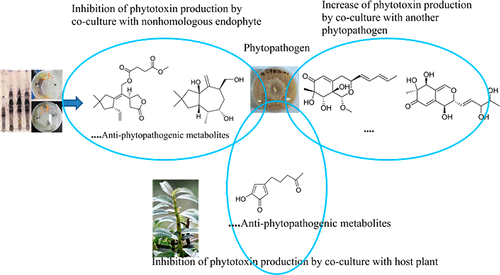当前位置:
X-MOL 学术
›
J. Nat. Prod.
›
论文详情
Our official English website, www.x-mol.net, welcomes your feedback! (Note: you will need to create a separate account there.)
The Cocultured Nigrospora oryzae and Collectotrichum gloeosporioides, Irpex lacteus, and the Plant Host Dendrobium officinale Bidirectionally Regulate the Production of Phytotoxins by Anti-phytopathogenic Metabolites.
Journal of Natural Products ( IF 5.1 ) Pub Date : 2020-05-13 , DOI: 10.1021/acs.jnatprod.0c00036 Li-Jiao Shi 1 , Ya-Mei Wu 1 , Xue-Qiong Yang 1 , Ting-Ting Xu 1 , Shuang Yang 1 , Xue-Yin Wang 1 , Ya-Bin Yang 1 , Zhong-Tao Ding 1
Journal of Natural Products ( IF 5.1 ) Pub Date : 2020-05-13 , DOI: 10.1021/acs.jnatprod.0c00036 Li-Jiao Shi 1 , Ya-Mei Wu 1 , Xue-Qiong Yang 1 , Ting-Ting Xu 1 , Shuang Yang 1 , Xue-Yin Wang 1 , Ya-Bin Yang 1 , Zhong-Tao Ding 1
Affiliation

|
The distinctive nature of the endophyte Irpex lacteus, host plant, and the phytopathogen Collectotrichum gloeosporioides resulted in both negative and positive regulation of the production of phytotoxins from Nigrospora oryzae. The coculture of nonhomologous I. lacteus and N. oryzae resulted in a greater number of anti-phytopathogenic metabolites from the dominant endophyte than the coculture of homologous I. lacteus and N. oryzae. The coculture of the phytopathogen N. oryzae and either the nonhomologous (isolation of I. lacteus and N. oryzae from the different plants) or homologous (isolation of I. lacteus and N. oryzae from the same plant) endophyte I. lacteus from different sources indicated that the nonhomologous I. lacteus grew faster than the homologous I. lacteus, and the production of phytotoxic azaphilone from the phytopathogenic N. oryzae decreased due to the inhibition resulting from being cocultured with nonhomologous I. lacteus. On the other hand, the production of phytotoxic azaphilone was promoted by the coculture of two phytopathogens, N. oryzae and C. gloeosporioides. The extract of the host plant, Dendrobium officinale, also increased anti-phytopathogenic metabolite production. Six new phytotoxic azaphilones from N. oryzae, four new tremulane sesquiterpenes from I. lacteus, and a new polyketone were isolated. The endophyte-phytopathogen, phytopathogen-phytopathogen, and endophyte-phytopathogen-host interactions can induce the chemical diversity of novel anti-phytopathogenic metabolites.
中文翻译:

共培养的稻草黑麦草和Collectotrichum gloeosporioides,Irpex lacteus和植物寄主石off通过抗植物病原代谢物双向调节植物毒素的生产。
内生真菌Irpex lacteus,寄主植物和植物病原菌Collectotrichum gloeosporioides的独特性质导致米曲霉植物毒素产生的负调控和正调控。与同源乳酸菌和稻瘟病菌的共培养相比,非同源乳酸菌和稻瘟病菌的共培养导致优势内生菌产生更多的抗植物病原代谢产物。植物病原体稻瘟病菌与不同源(不同植物的乳酸杆菌和稻瘟病菌的分离)或同源性(同一植物中乳酸菌和稻瘟病菌的分离)的共培养资料表明,非同源乳酸杆菌的生长快于同源乳酸杆菌,并且从植物致病性氮产生了具有植物毒性的氮杂苯醌。由于与非同源乳杆菌共培养而产生的抑制作用,稻米减少。另一方面,通过两种稻瘟病菌(N. oryzae)和球孢梭菌(C. gloeosporioides)的共培养,促进了植物毒性氮磷的产生。寄主植物铁皮石end的提取物也增加了抗植物病原代谢产物的产量。分离了来自稻瘟病菌的六种新的植物毒性氮杂苯甲酮,来自乳酸杆菌的四种新的三氢呋喃倍半萜和一种新的聚酮。内生植物致病菌,植物致病菌-植物致病菌和内生植物-植物致病菌-宿主相互作用可以诱导新的抗植物致病性代谢产物的化学多样性。两种植物病原体,米曲霉和球孢梭状芽孢杆菌的共培养促进了植物毒性氮杂苯醌的产生。寄主植物铁皮石end的提取物也增加了抗植物病原代谢产物的产量。分离了来自稻瘟病菌的六种新的植物毒性氮杂苯甲酮,来自乳酸杆菌的四种新的三氢呋喃倍半萜和一种新的聚酮。内生植物致病菌,植物致病菌-植物致病菌和内生植物-植物致病菌-宿主相互作用可以诱导新的抗植物致病性代谢产物的化学多样性。两种植物病原菌米曲霉和球孢梭状芽孢杆菌的共培养促进了植物毒性氮杂苯醌的产生。铁皮石D的提取物也增加了抗植物病原代谢产物的产量。分离了来自稻瘟病菌的六种新的植物毒性氮杂苯甲酮,来自乳酸杆菌的四种新的三氢呋喃倍半萜和一种新的聚酮。内生植物致病菌,植物致病菌-植物致病菌和内生植物-植物致病菌-宿主相互作用可以诱导新的抗植物致病性代谢产物的化学多样性。
更新日期:2020-05-13
中文翻译:

共培养的稻草黑麦草和Collectotrichum gloeosporioides,Irpex lacteus和植物寄主石off通过抗植物病原代谢物双向调节植物毒素的生产。
内生真菌Irpex lacteus,寄主植物和植物病原菌Collectotrichum gloeosporioides的独特性质导致米曲霉植物毒素产生的负调控和正调控。与同源乳酸菌和稻瘟病菌的共培养相比,非同源乳酸菌和稻瘟病菌的共培养导致优势内生菌产生更多的抗植物病原代谢产物。植物病原体稻瘟病菌与不同源(不同植物的乳酸杆菌和稻瘟病菌的分离)或同源性(同一植物中乳酸菌和稻瘟病菌的分离)的共培养资料表明,非同源乳酸杆菌的生长快于同源乳酸杆菌,并且从植物致病性氮产生了具有植物毒性的氮杂苯醌。由于与非同源乳杆菌共培养而产生的抑制作用,稻米减少。另一方面,通过两种稻瘟病菌(N. oryzae)和球孢梭菌(C. gloeosporioides)的共培养,促进了植物毒性氮磷的产生。寄主植物铁皮石end的提取物也增加了抗植物病原代谢产物的产量。分离了来自稻瘟病菌的六种新的植物毒性氮杂苯甲酮,来自乳酸杆菌的四种新的三氢呋喃倍半萜和一种新的聚酮。内生植物致病菌,植物致病菌-植物致病菌和内生植物-植物致病菌-宿主相互作用可以诱导新的抗植物致病性代谢产物的化学多样性。两种植物病原体,米曲霉和球孢梭状芽孢杆菌的共培养促进了植物毒性氮杂苯醌的产生。寄主植物铁皮石end的提取物也增加了抗植物病原代谢产物的产量。分离了来自稻瘟病菌的六种新的植物毒性氮杂苯甲酮,来自乳酸杆菌的四种新的三氢呋喃倍半萜和一种新的聚酮。内生植物致病菌,植物致病菌-植物致病菌和内生植物-植物致病菌-宿主相互作用可以诱导新的抗植物致病性代谢产物的化学多样性。两种植物病原菌米曲霉和球孢梭状芽孢杆菌的共培养促进了植物毒性氮杂苯醌的产生。铁皮石D的提取物也增加了抗植物病原代谢产物的产量。分离了来自稻瘟病菌的六种新的植物毒性氮杂苯甲酮,来自乳酸杆菌的四种新的三氢呋喃倍半萜和一种新的聚酮。内生植物致病菌,植物致病菌-植物致病菌和内生植物-植物致病菌-宿主相互作用可以诱导新的抗植物致病性代谢产物的化学多样性。



























 京公网安备 11010802027423号
京公网安备 11010802027423号